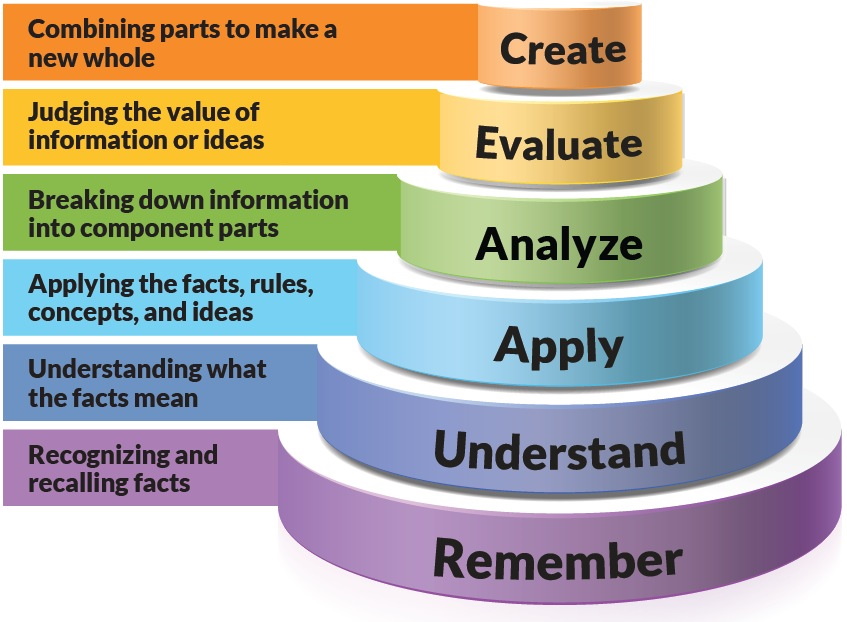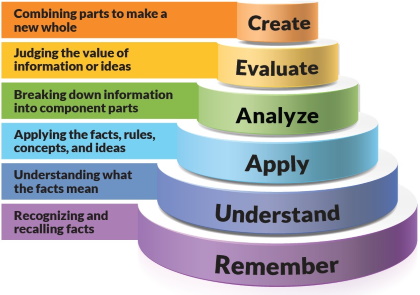Thinking Skills and English language learners
English language learners should be asked critical thinking questions from all levels of Bloom's Taxonomy. Some of the tasks on the taxonomy are difficult for ELLs because they lack the language and vocabulary to work in English. However, teachers need to ask questions from all levels of the taxonomy that are age appropriate and at the English language level of the English language learners. Even very young children can work at the Synthesis and Evaluation levels.
Examples at each level below come from Pa Lia's First Day by Michelle Edwards. This book is written at a late second or early third grade level.
Level 1: Knowledge. This level of questioning is what is most frequently used when teaching ELLs, especially for students in pre-production and beginning production levels of English language acquisition. Responses to some of the questions can be made using yes/no or embedded questions. Pictures, drawings, and realia will help students give the correct answer. Responses to these questions are generally right in the text. Here are some questions and directions you might ask:
- What did Pa Lia's brother do on the way to school?
- Who pushed Pa Lia on the steps?
- What name did Stinky call Pa Lia?
- When did Pa Lia meet Calliope?
- What did Pa Lia do during Math Class?
Level II: Comprehension. This level shows that the student has understood the facts and can interpret them. ESL/bilingual teachers use this level of questioning a lot. We ask students to compare, contrast, illustrate, and classify. We do this oral questions and graphic organizers such as Venn Diagrams and T-charts.
- Why did Pa Lia dawdle on the way to school?
- How will Pa Lia find her classroom?
- Why was Howie mean to Pa Lia?
- Why did Pa Lia get in trouble?
- Compare Calliope with Howie. Use the word bank.
- Make a drawing that shows how Pa Lia felt when she came in the classroom.
- Find a picture in the book that shows "Pa Lia felt like a teeny tiny minnow in a huge giant ocean".
Level III: Application. Students are learning to solve problems by using previously learned facts in a different way. ELLs might need scaffolding and word banks to build, choose, construct, develop, organize, plan, select, solve, and identify.
- Why did Pa Lia send a note?
- How would you do if you needed to find your classroom on the first day of school?
- Can you list the ways you could make a new student feel welcome?
- Write a different ending to the story.
- What questions would you ask Stinky if you could talk to him?
Level 4: Analysis. At this level students may not have enough vocabulary and language to express responses in English. The tasks at this level that English language learners will be able to complete with some teacher scaffolding are: classify, contrast, compare, categorize, sequence.
- How do we know Pa La felt nervous? Find the sentences in the story.
- Compare Pa Lia's feelings at the beginning of the story with her feelings at the end of the story.
- Sequence the following story sentences. What happened first?
- Look at the words in the word bank that describe people. Write the words that describe Pa Lia, Calliope, and Howie in the correct column
- Can you find four different feelings Pa Lia had during the story?
- How do you know that Pa Lia is the hero of the story?
- What do you think will happen next in this story?
Level 5: Synthesis. At this level students are compiling information together in a different way by combining elements in a new pattern or proposing alternative solutions. ELLs will need teacher support and scaffolding to answer questions at level 5. Synthesis is particularly difficult for ELLs. Students may be able to choose, combine, create, design, develop, imagine, make up, predict, solve, and change.
- Pa Lia is a new student at school and she has no friends. How would you solve Pa Lia's problem?
- How would you change in this story?
- What happens if you do not tell the truth?
- Can you invent another character for the story?
- How would you change the story to create a different ending?
- How could you change the story? How else could Pa Lia make friends? Plan a party for Mrs. Hennessey's class.Level VI: Evaluation. Questions at this level of Bloom's taxonomy can be modified so that the langue is simplified but the task remains the same. English language learners can learn to give opinions, make judgments about the action in a story and evaluate the work of an author.The vocabulary usually associated with evaluation may need to be simplified. Here are some questions ELLs would be able to answer with some scaffolding by the teacher.
- What do you think will happen if Pa Lia does not tell the truth.
- What didn't you like about the story? Why?
- Do you think Tou Ger was a good brother? Why or Why not?
- What is part of this book did you like best. Tell why you like it?
- Why did the Pa Lia decide to tell the truth?
- What would you do if you were Pa Lia and the teacher was angry with you?
- Read another story by Michelle Edwards. Do you like it better than “Pa Lia's First Day?”










